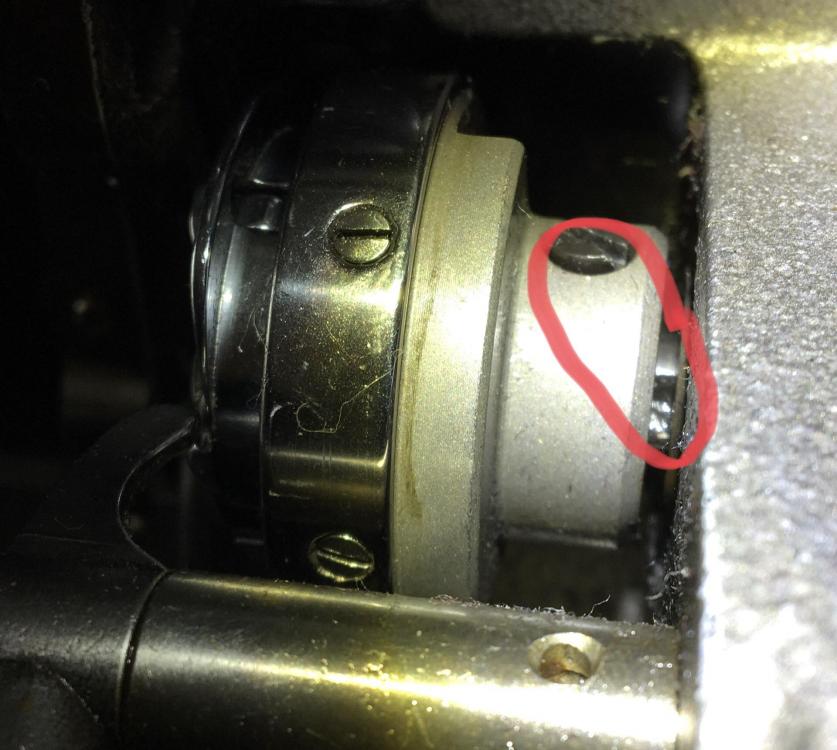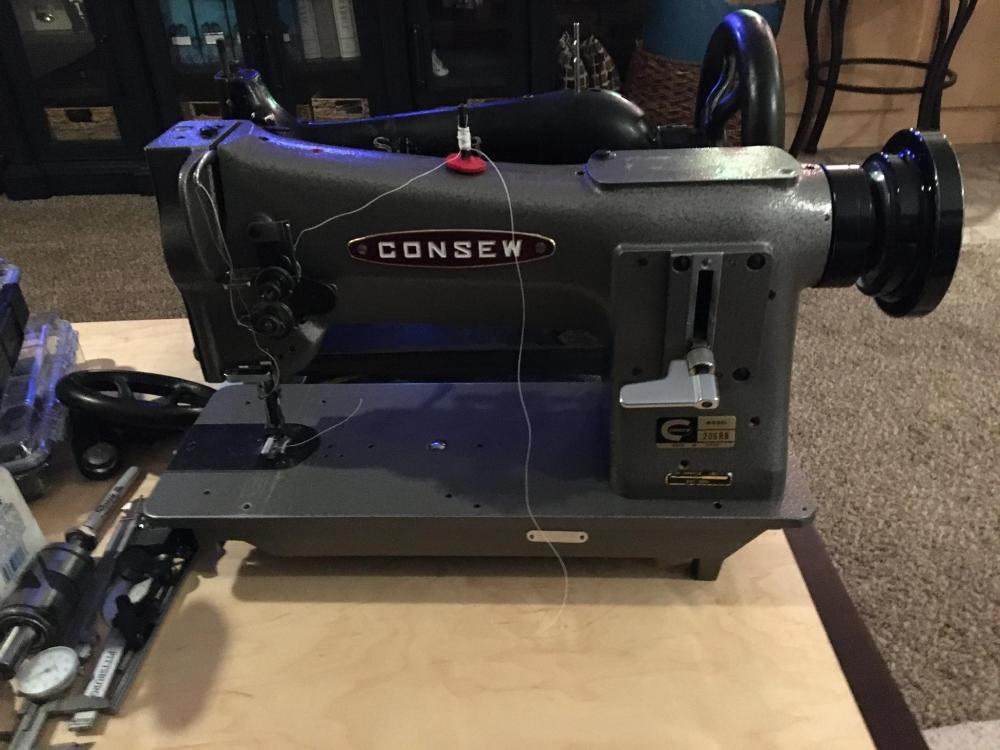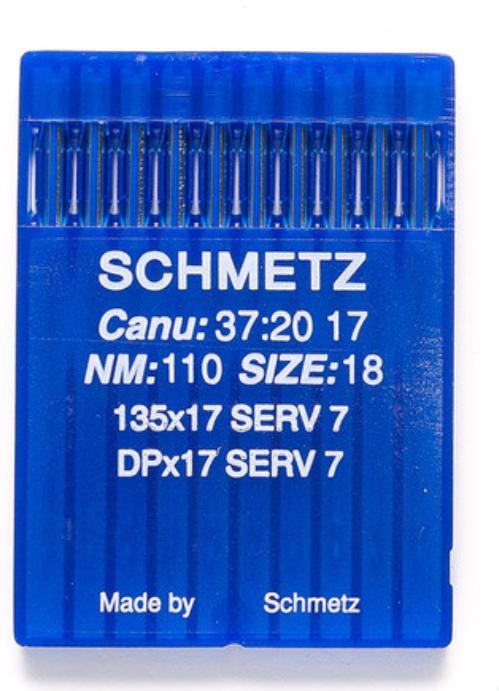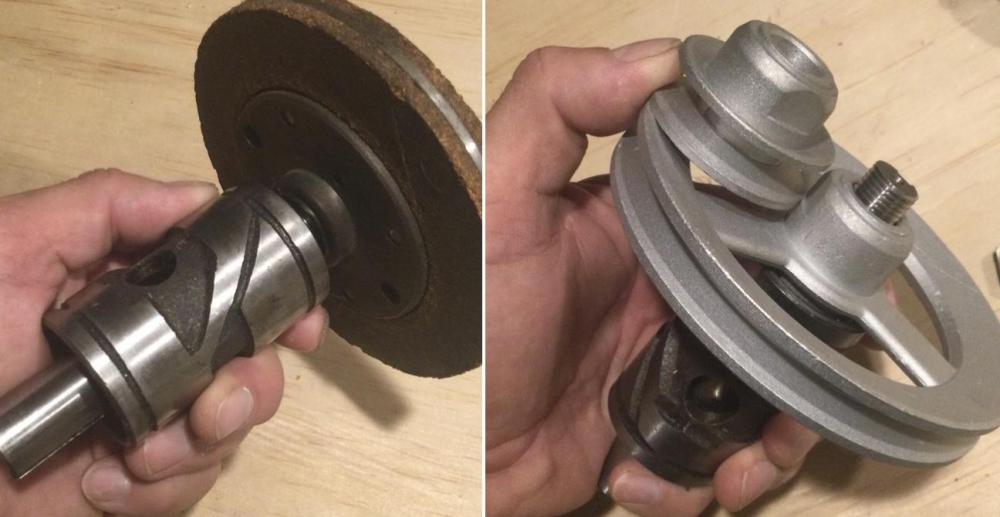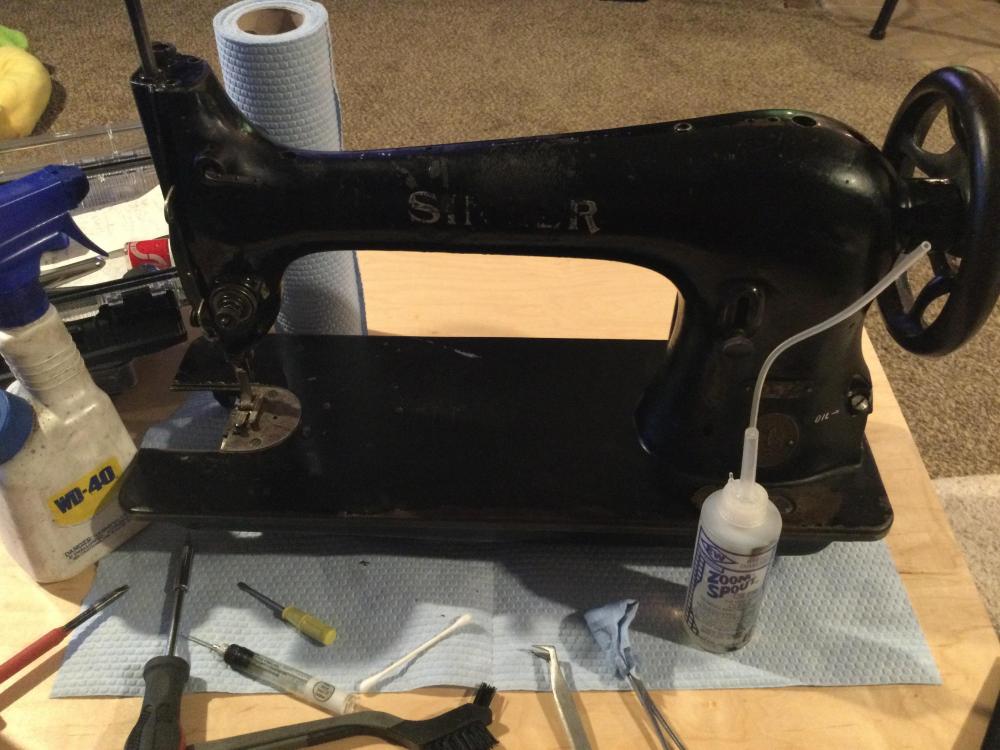-
Posts
794 -
Joined
-
Last visited
Content Type
Profiles
Forums
Events
Blogs
Gallery
Everything posted by DonInReno
-

Consew 206RB hook adjustment slippage
DonInReno replied to DonInReno's topic in Leather Sewing Machines
-

Consew 206RB hook adjustment slippage
DonInReno replied to DonInReno's topic in Leather Sewing Machines
Thanks Gregg - this information helped solve the problem in 5 minutes! All day at work I was wondering what the problem was going to be and hoping it was an easy fix. A quick check with a flashlight showed a screw not aligned with the corresponding v ditch. The person that worked on it was using the two screws on the hook to time it rather than the three that you pointed out. -
My latest machine is a made in Japan Consew 206RB-1 in very very good condition other than it had a long history of hook timing problems. It currently works fine, but the previous owner was convinced it will happen again soon, which is why she let it go for $100. A quick google search turns up a lot of people with 206RBs and slipping hooks - does anyone have any insight as to why this model might have this issue more than others? The previous owner had it retimed at the same sewing shop multiple times over the years and the screws on the hook appear to be properly tight. If anyone has a 206RB I’d love to hear what to watch out for.
-
I can’t answer the question about that particular model, but in general I wouldn’t suggest a worn out machine as a first industrial, especially at that price. Adler parts are not cheap, if available at all for an older model. In a production shop if a machine is set on the shelf for being worn out it’s not a simple fix, or they would have already fixed it. There are plenty of flat bedtripple feed machines in much better shape for that price.
-
You might check for groves worn in the take up arm and thread guides all along the thread path up top as well as down below. They may not affect the thinner thread that made the groves, but a slightly thicker thread gets wedged in these groves and can cause constant or intermittent high resistance so tensions are all over the place and can either cause too much tension at the needle or not enough depending on the restriction.
-

Another, what cylinder arm machine should I buy, post. Thanks!
DonInReno replied to Auden's topic in Leather Sewing Machines
Uwe’s videos are excellent! Something is preventing the hook from grabbing the loop of thread at the needle creating the skipped stitch. As always make sure you have a fresh needle before making any adjustments. If your needle timing is spot on and the gap between needle and point of the hook is as small as possible without actually touching, then you might have a poorly shaped hook. Every time a needle breaks or otherwise impacts the point of the hook it dulls it slightly. A nice sharp hook will grab the thread loop more reliably and break thread much less often when the thread grab isn’t perfect. If the machine is new to you it might be a case of bad hand-me-down parts. Dull hooks are often resharpened with mixed results, and some inexpensive hooks just have terrible shapes that work poorly even when new. When selling a machine it’s common for a shop or person with multiple machines of the same type to combine all the crappiest parts into the one that’s going to be sold. A slightly dull hook that’s otherwise of good quality and proper length and shape can be sharpened, but often if the point is quite dull it will also be much shorter than it was originally. The stiffness of thread also effects the size of thread loop at the needle - just last week a sewer was having problems with some new thread - turned out they were trying to use a soft thread that’s not bonded. Only use bonded thread. Hopefully you find the gremlin that’s causing problems. -

Another, what cylinder arm machine should I buy, post. Thanks!
DonInReno replied to Auden's topic in Leather Sewing Machines
No, not at all. Industrials are built to be reliable and trouble free for very large amounts of sewing. What kinds of issues are you having with the 111w155 that require so much troubleshooting? -

Help needed with hand crank cobbler machine!
DonInReno replied to LK1's topic in Leather Sewing Machines
I have a non-answer that probably won’t solve your problem directly, but will hopefully help get you closer. The patchers are interesting little machines, and when all the issues are sorted out they do make a stitch, but you’ll have to fix a half dozen issues just to barely have a reliable machine. First, throw out the thread that comes with it and order a spool of 92 weight bonded nylon. If you later want to try a thicker thread you can, but this is the easiest of the thicker threads to figure out - rather than pushing the limits right off the bat, get 92 to work first. Second, remove roughness from everything the bobbin thread comes into contact with. Use some 400 grit sandpaper and polish off sharp corners that the thread has to drag across - including the little holes in the hook that the thread gets dragged through. Third, get comfortable with thread tension adjustment. Only use one tensioner - the second is intended for winding bobbins - regardless of how many well intentioned people say to use both don’t do it. If two tensioners were any advantage, every industrial would have two, but they don’t. Make sure your hook has a bobbin thread tension spring - some only have holes and no spring - order a new hook if need be, but you have to have a tension spring. Now adjust the top tension so the knot is centered in the material - normally the bobbin tension is close enough to get you started so just leave the bobbin alone and make adjustments with the top tensioner. Every time you sew check this and make adjustments as needed. Fourth, there’s no getting around the proper clearance between the needle and hook and proper timing. If you’re lucky your machine will make a basic stitch as set at the factory, but there is 1 in 100 chance it’s set correctly. I’ve read two dozen descriptions of how to do this on the patcher forum on FB and most people are well meaning, but they are a little off base so don’t believe the first write up on his. Just keep in mind as the needle is at the very bottom of its stroke, and then rises the thickness of a nickel, the point of the hook should just be inline with the needle about 1/16” up from the eye of the needle. The point of the hook should be as close to the needle as possible without actually touching it. Order new high quality needles - always make your timing and hook clearance adjustments with a new needle. A slightly bent needle is the easiest thing to correct and should be the first thing you do when troubleshooting. Fifth, practice sewing as much as possible to get a feel for the machine and what issues are normal and which are signs something is wrong. It’s not possible to just jump in and start sewing on a project and expect it to turn out right. Good technique isn’t easy, or everyone would be making professional looking items from day one. We all want to help someone who is putting in the time to increase their skills, but it makes me cringe when someone unwraps a patcher and starts complaining the monofilament fishing line included with the machine doesn’t make a good looking stitch and they just ruined a good belt with crooked stitches....oh, and they don’t want to practice. Sixth, every part of the patcher, every bolt, every adjustment, every everything, is likely to cause problems at some time in the future because of the inexpensive nature of the construction, so don’t expect miracles and accept troubleshooting as a necessary skill when running one of these. There are a lot of articles out there describing how to sort out each part to make it more reliable. Like I said, this isn’t really a specific answer to your problem, although your issue is most likely somewhere in those first four points. Fix and eliminate as many small issues as possible and the solution to bigger problems will be much much easier to diagnose. Good luck and let us know what fixed the problem! -
That made me chuckle out loud. :-)
-
Rachael, “135x16” is the type of needle, but that is not the size of eye in the needle. The “16” seems to throw people off, but just remember it’s nothing to do with eye size. Also keep in mind “135x16” is for leather - for carpet or fabric you want to use “135x17”. For #69 you’ll want an 18 size needle. It’s definitely confusing at first because needles often have a lot of other information that clouds the waters. A pack of needles will look something like the photo below - you just want to make sure it states the correct size - size 18 for your thread - and that it states 135x17. All the other numbers are what this kind of needle is referred to by other manufacturers, so don’t be concerned with them. I hope this helps.
-
Access to speed reducers are such a common issue with those new to industrial sewing it’s been fun to figure some low cost ways to cobble one together. A while back I picked up a couple of cheap pillow block bearings, a short section of rod and two cheap steel pulleys, and that reducer was over $40. I figured there must be a cheaper way.
-
In the past I’ve suggested making an inexpensive speed reducer from the output bearing housing and shaft of a clutch motor, but had never tried it myself. To see how inexpensively it could be done I ordered a few pulleys and stripped the shaft and out of a mid-70s clutch motor. The sewing machine pulleys were ordered from a Chinese company on EBay and were only $16.41 shipping included. One is a 45mm and the larger is a 120mm with 15mm bores that happens to fit perfectly in place of the clutch disk. There are probably larger sewing machine pulleys for the big one, but that’s the max from this seller. I’ll hacksaw off a bit of the hub on each pulley so they can be stacked together and still be held on with the nut. The old output shaft stub isn’t used so I’ll hacksaw off that end to tidy it up. The 42mm (about 1-5/8”) round bearing housing will need to be epoxied into a hole in a piece of hardwood and bolted to a table in a way that allows it to be adjustable. Hopefully I’ll have time to finish it sometime this week and give it a test drive :-)
-

Singer 16-41 hook and needle timing help.
DonInReno replied to Restorer's topic in Leather Sewing Machines
That’s interesting. Does it have a hook that’s built backwards, or a gear to reverse the rotation of the hook? -

Amazon shoe patcher machine frustrations
DonInReno replied to Loudcherokee's topic in Leather Sewing Machines
The FB group on these has a good collection of files that details how to troubleshoot and what needles to use. The members of that group are pretty enthusiastic about the machine and you’ll find some good help if you are careful about sifting through the people that don’t know what they are doing from those that do. -
1/4 lb spools are quite common - in 138 that’s about 700 yards and runs somewhere around $10 - slightly more from larger thread suppliers and slightly less from no-name online sources. My vote goes for the Thread Exchange. Good prices, good information, good selection. The absolutely cheapest thread on eBay may be $10 per lb, but be careful of old thread because the waxes on the thread tend to cause sticking and the the resulting uneven stitch tension. Big sewing shops will have spool rewinders just to be able to use thread that begins to stick, but it’s just not easy for the home gamer.
-
https://www.google.com/url?sa=t&rct=j&q=&esrc=s&source=web&cd=&ved=2ahUKEwiRys_-4P7tAhWLsJ4KHa91CCwQFjAAegQIBBAC&url=https%3A%2F%2Fwww.manualslib.com%2Fmanual%2F364314%2FSinger-111w156.html&usg=AOvVaw0_AqBhxvBaj5upBw8yezmC
-
If you google it, the first three links all have the manual you’re looking for.
-
You might check under the base where the chain may go up inside hidden from view. That’s a pretty cool machine you’ve got there.
- 14 replies
-
- and many more
- singer 153w
-
(and 4 more)
Tagged with:
-
In my area old Singer 31-15 machines pop up every few months for $50 or less - we have very low humidity so even 30 years in a garage will barely produce any surface rust and these long ignored old gals tend to be easy to clean up. This one from 1921 was $35 and has no noticeable wear on any of the thread guides and most screws are still in perfect shape. I’ve always thought the old 31-15 are the best deals for anyone new to sewing since they are so simple and durable, but they almost have to be given away. Even worse, relatives won’t even take a free one unless it’s all set up with servo and table! Well I’ve scratched my head over this for years and am trying a new angle that hopefully a few teenage relatives will appreciate - setting a few of these up with compact table top bases, a compact servo and simple speed reducer. It will be a hard sell to convince them this is better than a plastic disposable new Singer from Walmart! ...and God forbid if a kid nowadays had to sacrifice three or four feet of precious room for a dedicated sewing table! Lol Over the years various posts have shown table top bases, but I’ve never paid attention until now - if anyone has a favorite design, especially if it includes a speed reducer, I’d enjoy seeing them.
-

Beginning Sewer looking for general advice
DonInReno replied to MtlBiker's topic in Leather Sewing Machines
I was just roaming through a local fabric store that has a very large amount of left over ruminant fabrics (end of run leftovers), so the selection is always changing, and this post came to mind. When you have a chance to visit a big store with a large selection of heavy fabrics it will be well worth it. It’s hard to describe the wide variety of heavy synthetic fabrics available now - super heavy 3000d, super supple 1000d, 1600d rip stop, super stiff stiffener, super coarse weave 1600d, and the same down through the thinner weights. I can’t imagine appreciating the weaves and feel without actually seeing it in person, so the more samples you can get in your area the better. Then there are the vinyl coated polyester “tarp” fabrics that are bulletproof and are nice to use in high wear areas. I can definitely see these used in some kinds of firewood haulers. Then there are the heavy cotton canvas fabrics - almost as much variety as the synthetics. I don’t know where this store gets leather scraps, but at a few bucks a pound it’s a steal. Just keep looking and don’t overlook eBay, Craigslist and whatever other sites you have up there - sometimes one person will clearance out a given thing and you can buy a lifetime supply for cheap. It will take many generations to use up all the YKK bulk zipper I bought at a military surplus store a few years ago. *chuckle* -

Understanding Bonded Nylon and Bonded Polyester Thread
DonInReno replied to Trouthunter's topic in Leather Sewing Machines
There’s nothing wrong stocking up on as many colors and sizes of good quality thread, two spools of each of course, but you can quickly have more money in thread than the cost of your first machine. A few years back I took the chance in ordering a bunch of thread directly from Hong Kong in a variety of commonly used colors in both 92 and 138. The sale price including shipping was so inexpensive, about $2.50 for a quarter pound spool, my expectations were low - maybe this was reject thread, or a scam, or it’s so old it wouldn’t smoothly come off the spool, or it’s mislabeled, etc. It turned out to be good quality and worth the incredibly long shipping. I wouldn’t recommend this for professional sewers since it could be hit or mis, but in this one case it turned out to be money well spent. -

Understanding Bonded Nylon and Bonded Polyester Thread
DonInReno replied to Trouthunter's topic in Leather Sewing Machines
This is another good source of thread and information: https://www.thethreadexchange.com/miva/merchant.mvc?Screen=CTGY&Category_Code=industrial-thread -

Understanding Bonded Nylon and Bonded Polyester Thread
DonInReno replied to Trouthunter's topic in Leather Sewing Machines
The main difference between nylon and polyester has to do with UV resistance and strength. Nylon is a little bit stronger, but doesn’t hold up in direct sun. -

Reliable Barracuda and its look a likes
DonInReno replied to Trouthunter's topic in Leather Sewing Machines
...apparently my memory is as bad as an eBay shipping box! I was moving a hot tub cover that was sewn with a Sailrite clone and I would have sworn everything built with that machine was sewn with 138, but it was only 92 - I was wrong about it sewing 138 with a few simple adjustments since if it would have worked with 138 that’s what would have been used. Oops. On another topic, I hear Sailrite now makes a smooth feed dog for these machines. -

servo motor on vintage domestic sewing machine
DonInReno replied to Mike124's topic in Leather Sewing Machines
Hi and welcome. To anyone thinking of an industrial on a tight budget I suggest you think of them as three distinct parts that don’t have to be purchased together - head, table and motor. The head of a simple drop feed industrial can be dirt cheap - $50 to $100 is common, especially for vintage machines. Keep in mind many people selling vintage sewing machines have no use for it - it belonged to a relative who passed, a wife that left, or was left behind in a rental. About every six months I see a complete functional industrial with table and clutch motor listed as free. Heck, this past year there was even a complete walking foot industrial being given away. Unless there was something special about it, $100 would be the max for a simple sewer in working condition - a near new simple sewer with servo motor can be had for $200 in many areas, so don’t pay too much for one. Needle feed machines sew heavier material better, but they are not as good for leather as a walking foot - a good deal on these range between $50 and $150 (if someone isn’t a sewer that don’t see the difference between a drop feed machine and needle feed.) For the cheapest walking foot industrial, there are two kinds - old obsolete models that are true walking foot machines, but parts are nonexistent, and then there are old factory machines that have been around the block a few times and may need the common wear parts updated. An obsolete machine will be cheaper up front, but has no long term value. An old factory machine like 111w155 Singer has more value since it’s easily repairable and will be worth as much in 20 years as it is today. Tables often pop up for $50 all the time and usually include a high speed clutch motor. Free listings are not uncommon. Heck, I’ve given away a table about every other year and there are many others who would rather give it away than try to find a dumpster for it. Servo motors are relatively new so there’s no getting around having to buy one for full price, although that is starting to change, and prices are pretty reasonable. A commercial speed reducer will rarely show up used, but two pulleys, two pillow block bearings and a short shaft can be fairly easily made into one....if you enjoy messing around with such things. ....that’s a long winded way of suggesting you can probably afford an industrial and that’s a better use of time and effort.



